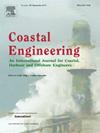Wave-induced hydrodynamics of biogenic structures in the central Wadden Sea: Implications of the transformation from mussel beds to oyster reefs for wave attenuation
IF 4.5
2区 工程技术
Q1 ENGINEERING, CIVIL
引用次数: 0
Abstract
The transformation of the predominant biogenic structures in the Wadden Sea, from blue mussel (Mytilus edulis) beds to Pacific oyster (Magallana gigas) reefs, has increased their topographical roughness, impacting the wave-biogenic structure interactions. Despite the general knowledge of increased wave attenuation due to the ecological transformation, a detailed quantification of wave energy dissipation induced by both biogenic structures and a comprehensive understanding of the governing processes remain lacking. This study systematically investigates frictional wave energy dissipation of both biogenic structures by subjecting generic surrogate models to regular, non-breaking waves in reduced-scale wave flume experiments. The results reveal pronounced wave height reductions for both structures, with oyster reefs exhibiting approximately twice the frictional wave energy dissipation (wave friction factor fw,OR = 0.44 ± 0.30) of mussel beds (fw,MB = 0.21 ± 0.18). Comparing near-bed velocities with topographical roughness parameters identified mussel agglomerations governing the frictional wave energy dissipation in mussel beds and oyster shells in oyster reefs. In mussel beds, form drag dominates frictional resistance under moderate hydrodynamic conditions, whereas flow separation at high intensities substantially lowers the wave energy dissipation. Conversely, oyster reefs maintain wave energy dissipation across a broader hydrodynamic range due to the sharp-edged, rigid shells. The enhanced wave attenuation by oyster reefs and their expected long-term persistence in the Wadden Sea presents an opportunity to complement existing gray coastal protection infrastructure as a nature-based solution. The parameterization of frictional wave energy dissipation presented here enables more accurate hydro-morphodynamic modeling of large-scale sediment dynamics in such soft-bottom environments.
瓦登海中部生物成因结构的波浪诱导水动力学:贻贝床向牡蛎礁转变对波浪衰减的影响
瓦登海的主要生物成因结构由蓝贻贝(Mytilus edulis)床向太平洋牡蛎(Magallana gigas)礁转变,增加了其地形粗糙度,影响了波浪-生物成因结构的相互作用。尽管普遍认识到由于生态转变而增加的波衰减,但生物结构引起的波能量耗散的详细量化和对控制过程的全面理解仍然缺乏。本研究系统地研究了这两种生物成因结构的摩擦波能量耗散,方法是在缩小尺度的波浪水槽实验中,将通用替代模型应用于规则的非破碎波。结果表明,两种结构的波高都明显降低,牡蛎礁的摩擦波能量耗散(波摩擦系数fw,OR = 0.44±0.30)约为贻贝床(fw,MB = 0.21±0.18)的两倍。通过比较近床速度和地形粗糙度参数,确定了贻贝团块控制着贻贝床和牡蛎礁中牡蛎壳的摩擦波能量耗散。在贻贝床中,在中等水动力条件下,形式阻力大于摩擦阻力,而高强度的流动分离大大降低了波浪能量耗散。相反,牡蛎礁由于边缘锋利、坚硬的外壳,在更宽的水动力范围内保持波浪能量耗散。牡蛎礁增强了波浪的衰减,它们在瓦登海的预期长期持久性为补充现有的灰色海岸保护基础设施提供了一个机会,作为一种基于自然的解决方案。本文提出的摩擦波能量耗散参数化方法,可以更精确地模拟软底环境下大尺度泥沙动力学过程。
本文章由计算机程序翻译,如有差异,请以英文原文为准。
求助全文
约1分钟内获得全文
求助全文
来源期刊

Coastal Engineering
工程技术-工程:大洋
CiteScore
9.20
自引率
13.60%
发文量
0
审稿时长
3.5 months
期刊介绍:
Coastal Engineering is an international medium for coastal engineers and scientists. Combining practical applications with modern technological and scientific approaches, such as mathematical and numerical modelling, laboratory and field observations and experiments, it publishes fundamental studies as well as case studies on the following aspects of coastal, harbour and offshore engineering: waves, currents and sediment transport; coastal, estuarine and offshore morphology; technical and functional design of coastal and harbour structures; morphological and environmental impact of coastal, harbour and offshore structures.
 求助内容:
求助内容: 应助结果提醒方式:
应助结果提醒方式:


